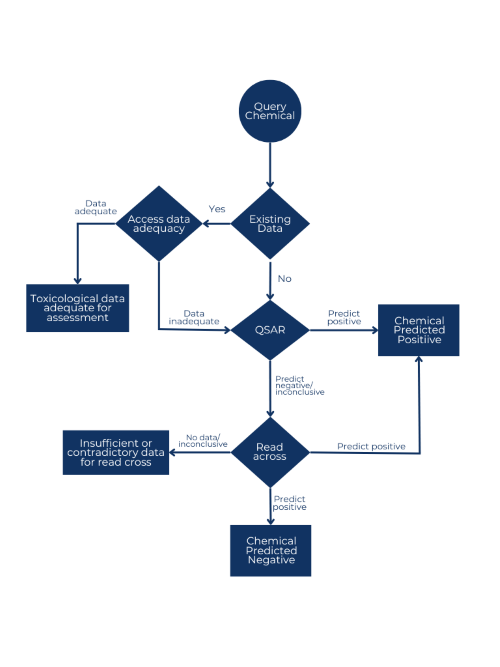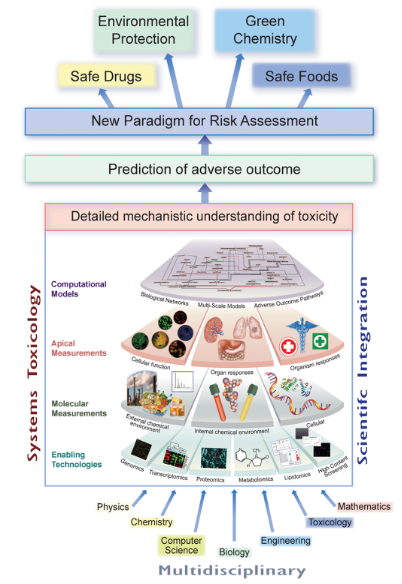Risk Assessment
- About
- Next-generation Risk Assessment at SaferWorldbyDesign
- Our solutions for you
- Our services
- Partner contribution
- ToxCalc!
- Request further information
- Order Links
About
SaferWorldbyDesign is able to provide a more comprehensive and integrated risk assessment for its customers' products by leveraging the expertise of partners such as Team mastery, Biobide, TERA, and SafeDose. This allows us to effectively evaluate and mitigate potential risks associated with a customer's products, leading to a more thorough and reliable assessment overall. Our services are complemented by our risk assessment knowledge infrastructure coordinated by Edelweiss Connect supporting product data management, modelling, and margin of safety evaluation for risk assessment reporting. Our approach starts from the definition of the best strategy to fulfill the regulatory needs with the possibility of applying New Approach Methods (NAMs) with the advantage of using a procedure that can be defined as holistic, modern, and ethically acceptable. Each potential project is studied carefully with tailored solutions to reduce the costs without reducing the scientific robustness. Our service can be applied for the definition of the hazard of mixtures, to understand the toxicological profile of research products, or for the justification of a Read Across approach.

[1]
To ensure the quality and integrity of the risk assessment process, authorities have defined guidelines and workflows which have to be followed. One example is the Risk Assessment process for chemicals for concern of skin sensitization where the OECD has elaborated a detailed guideline on how to proceed during risk assessment. Based on key events for skin sensitization, assays have to be performed in combination with in silico decision tree or machine learning approaches. Based on the experimental outcomes, the chemicals are scored leading to a prediction for their potential of being a skin sensitizer and providing a potency supporting an acceptable margin of safety.
Such new approach methods and guidelines are currently being elaborated for numerous biological events, pathways and outcomes. In emerging fields such as nanoscience, where molecular mechanisms that may lead to toxicity remain unclear, it is important to improve the understanding of such mechanisms. With this progress, new assays and methods can be developed to assess the risk of compounds and materials and to make the world a safer and greener place.
[1] Image adapted from Applicability of QSAR analysis in the evaluation of developmental and neurotoxicity effects for the assessment of the toxicological relevance of metabolites and degradates of pesticide active substances for dietary risk assessment prepared by Andrew Worth, Mojca Fuart-Gatnik, Silvia Lapenna and Rositsa Serafimova, 31st May 2011.
Next-generation risk assessment
Following the 3R principles (Replace, Reduce, Refine) new approach method scientists seek ways to generate high quality research evidence in toxicology without unneeded animal testing. With the development of new tissue and organoid models, it is nowadays possible to test compounds with high predictability for effects in different organisms including humans. To ensure integrity of the experimental outcomes, authorities, such as the OECD, EFSA, EPA, FDA and others, have elaborated specific guidelines on procedures which have to be followed during risk assessment. Those guidelines include workflows and decision trees, requirements during in vitro experimentation which have to be considered for scoring compounds, the definition of key events for specific endpoints and the criteria for evaluating compounds as positive or negative based on the experimental outcomes, to name only a few.
Based on those guidelines it is not only possible to develop assays in concern of specific key events but to also evaluate already existing data by in silico approaches and to characterize existing and new compounds with concern of their potential risk for organisms. Together, the methods are used in an integrated approach to assess the risk of compounds. This is used to make important decisions during product development that lead in the development od safe and sustainable products.

[1]
[1] Image from Basic research to risk assessment by Shana J. Sturla, Alan R. Boobis, Rex E. FitzGerald, Julia Hoeng, Robert J. Kavlock, Kristin Schirmer, Maurice Whelan, Martin F. Wilks and Manuel C. peitsch, 2014.
Our services
At SaferWorldbyDesign we offer a wide range of different packages specific to your needs and interests. Together with our partners we offer characterisation solutions for specific organ targets where we follow authority guidelines to ensure data integrity. Those solution areas include SaferSkin, SaferNeuron, SaferLiver, EndocrineDisruption, SaferLung, Nephrotoxicity, Toxicogenomics, RiskAssessment, DataServices and Ecotoxicity. Thereby, our solutions include next generation cell-, tissue- and organoid models which can be used for risk assessment assays, as well as in silico prediction models to predict potential risks of compounds based on machine learning and modelling approaches. If you are in need to evaluate your ingredient with concern for its toxic effects, please feel free to reach out to us for an initial consultation.
Partner Contribution
SafeDose
SafeDose Ltd. is a Canadian human health risk assessment consultancy and software development company. We help our clients deliver risk assessments that inspire confidence. We know that doing a chemical safety assessment is complicated. It is easy to get lost in the maze of data, regulations and risk assessment methods.
> Read more
SmartTox
SmartTox is a “Born Global Company”, as it was born operating in the international market. It has national and international partners with over 30 years of experience in the agrochemical market and vast expertise in regulatory toxicology and applied chemistry.
> Read more
Team Mastery
Born in 2008 as a dedicated REACH consulting company, TEAM mastery now provides a range of services in Chemical Regulatory Affairs. The staff is a highly motivated team with specific expertise in chemistry, biology, toxicology, pharmacology, human health, environmental toxicology, and risk assessment.
> Read more
CAAT-Europe - Understand the toxicological profile
Assistance in the compliance of regulatory requirements for the elucidation of the toxicological profile of substances and mixtures. This activity may include:
- New tests and strategies for CLP purposes, including classification of mixtures
- Preparation of read across (RAx) justification reports, including strategy for new tests to support the RAx hypothesis
- Development of a strategy for the characterization of toxicological properties of new products
- Scouting of less toxic products during the analysis of alternative substances, in the scope of replacing substances of very high concern (SVHCs)
- Elucidation of toxicological properties that are not directly addressed by regulatory requirements, deriving from specific concern or specific applications
- Evaluation of a testing strategy to complement old in vivo studies for reproductive toxicity, missing important information on endocrine disruptor activity or DNT assessment.
- Characterization of new materials, such as microplastics or nanomaterials
> Read more
Biobide
Our toxicology assessment covers a wide range of assays supported by our well-consolidated Zebrafish model. Our expertise includes areas of general toxicity as well as organ-specific toxicities.
> Read more
BiologicsHub
BiologicsHub is a highly experienced safety assessment service provider who has an excellent track record in delivering cost-effective projects on time, with high customer satisfaction to our pharmaceutical company partners.
> Read more
TERA
TERA is an environmental science NGO that builds collaborations among groups to solve risk assessment issues for various chemicals and has an active public outreach.
> Read more
TissUse
TissUse has developed a unique, proprietary and patent-protected “multi-on-a-chip” technology platform to accelerate the development of pharmaceutical, chemical, cosmetic, and personalized medical products.
> Read more
ToxCalc!

SaferWorldbyDesign provider SafeDose Ltd. is a Canadian human health risk assessment consultancy and software development company. The team at SafeDose recognizes that chemical safety assessments can be challenging, involving a wide range of data, regulations, and assessment methods. Despite this complexity, they are committed to guiding clients through the process and ensuring the development of high-quality assessments.
About
ToxCalc! is a website purpose-built for toxicologists and other scientific professionals to help us do routine calculations. The goal of ToxCalc! is to help those of us who assess chemical hazards and risk work faster, with fewer errors, using the best available evidence. ToxCalc! is also designed to promote the principles of systematic review. It wants you to record and reference the calculations and default values you used and append them to your chemical safety reports so that everyone can see where the numbers came from. Finally, ToxCalc! is also designed to help you understand the math and biology behind the calculations through the use of tutorials and help features.
What ToxCalc! Currently Does
Currently, ToxCalc! implements five multidirectional calculators (converts between doses and concentrations, animal and human doses, corrects for bioavailability, and calculates health-based exposure limits).
> Try the calculators now
How to Contribute?
We would love to have you contribute to this project!
If you are a toxicologist or scientific professional working in chemical safety assessment, we’d welcome your suggestions for calculations. We will prioritize calculations that are most useful to a broad audience, published in peer-reviewed journals or regulatory guidelines, and validated. Please cite the URL, or preferably, the published reference when submitting your request. If your calculation is accepted, you will be recognized as a ToxCalc! contributor. Another way to contribute is to act as a peer reviewer. Peer reviewers check the accuracy and relevance of the calculators and tools within ToxCalc!. If you’d like to be a peer reviewer, let us know here.
Are you a software developer, expert in math, visual design, usability, or any other discipline that ToxCalc! could benefit from? Get in touch here. You may earn coursework or certification credits by working on this project.
If you are interested in our developing and deploying such resources to support your work, please contact us here to discuss your requirements and obtain a proposal.
Reference:BBD-STA-CA
Vendor:Biobide
Product: Zebrafish Organ Specific Toxicity Assays: Cardiotox Assay
Reference:BBD-STA-HA
Vendor:Biobide
Product: Zebrafish Organ Specific Toxicity Assays: Hepatotox Assay
Reference:BBD-STA-IA
Vendor:Biobide
Product: Zebrafish Organ Specific Toxicity Assays: Immunotox Assay
Reference:CAAT-E-IVT
Vendor:CAAT-Europe, Konstanz University
Product: Strengthen existing in vivo tests
Reference:CAAT-E-NS
Vendor:CAAT-Europe, Konstanz University
Product: Characterisation of a New substance
Reference:SMART-TOX-01
Product: Predictive Toxicology (Q)SAR
Reference:SMART-TOX-02
Product: Risk Assessment (Non-dietetic, dietetic, human, occupational and environmental)
Reference:SMART-TOX-03
Reference:TERA-Peer
Vendor:Toxicology Excellence for Risk Assessment (TERA)